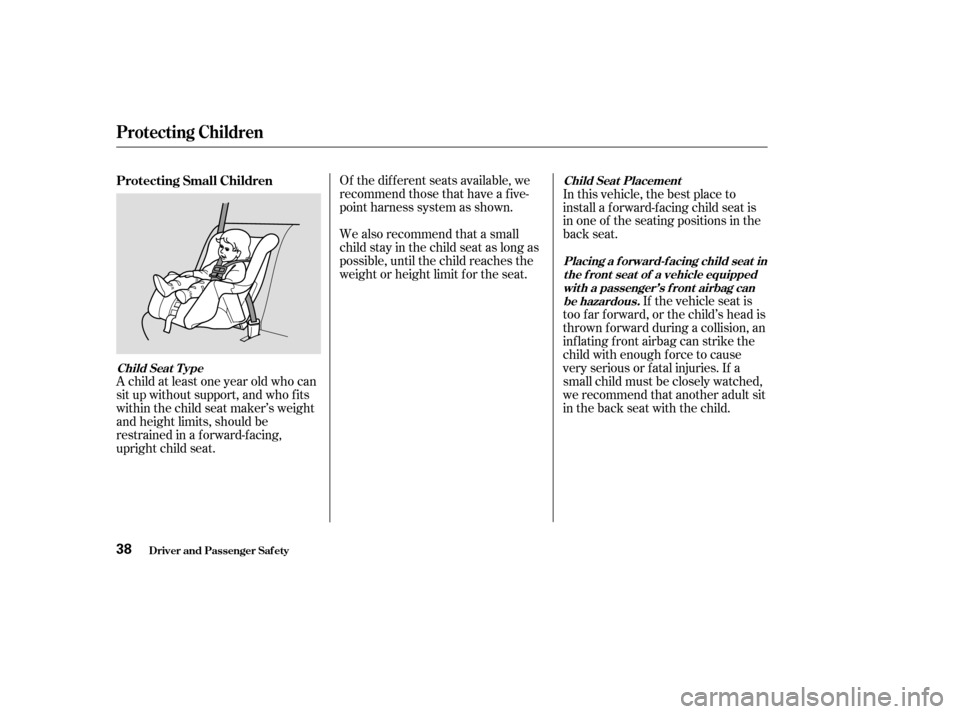Page 38 of 374

Only a rear-f acing child seat provides
proper support f or a baby’s head,
neck, and back. Inf ants up to about
one year of age must be restrained in
a rear-f acing child seat.
Two types of seats may be used: a
seat designed exclusively f or inf ants,
or a convertible seat used in the rear-
f acing, reclining mode.In this vehicle, a rear-f acing child
seatcanbeplacedinanyseating
position in the back, but not in the
front seat.
If the passenger’s
f ront airbag inf lates, it can hit the
back of the child seat with enough
f orce to kill or seriously injure an
inf ant. If an inf ant must be closely
watched, we recommend that
another adult sit in the back seat
with the baby.
If placed
f acing f orward, an inf ant could be
very seriously injured during a
f rontal collision.
We recommend that an inf ant be
restrained in a rear-f acing child seat
until the inf ant is at least one year
old, reaches the seat maker’s weight
or height limit, and is able to sit up
without support.
Protecting Inf ants
Child Seat T ype
Rear-Facing Child Seat Placement
Never put a rear-f acing child seat inthe front seat.
Do not put a rear-f acing child seat ina f orward-f acing position.
Protecting Children
Driver and Passenger Saf ety34
Placing a rear-facing child seat
in the front seat can result in
serious injury or death if the
passenger’s front airbag inflates.
Always place a rear-facing child
seat in the back seat, not the
front.
Page 40 of 374

To activate the lockable retractor,
slowly pull the shoulder part of the
belt all the way out until it stops,
then let the belt f eed back into the
retractor (you might hear a
clicking noise as the belt retracts).
Af ter the belt has retracted, tug on
it. If the belt is locked, you will not
be able to pull it out. If you can pull
the belt out, it is not locked and
you will need to repeat these steps.Push and pull the child seat
f orward and f rom side to side to
verif y that it is secure enough to
stay upright during normal driving
maneuvers. If the child seat is not
secure, unlatch the belt, allow it to
retract f ully, then repeat these
steps.
Af ter conf irming that the belt is
locked, grab the shoulder part of
the belt near the buckle and pull
up to remove any slack from the
lap part of the belt. Remember, if
the lap part of the belt is not tight,
the child seat will not be secure.
To remove slack, it may help to
putweightonthechildseat,or
push on the back of the seat, while
pulling up on the belt.
3.
4.
5.
6.
Protecting Children
Driver and Passenger Saf ety36
Page 42 of 374

Of the different seats available, we
recommend those that have a f ive-
point harness system as shown.
We also recommend that a small
child stay in the child seat as long as
possible, until the child reaches the
weight or height limit f or the seat.In this vehicle, the best place to
install a f orward-f acing child seat is
in one of the seating positions in the
back seat.
If the vehicle seat is
too far forward, or the child’s head is
thrown f orward during a collision, an
inflating front airbag can strike the
child with enough f orce to cause
very serious or f atal injuries. If a
small child must be closely watched,
we recommend that another adult sit
in the back seat with the child.
A child at least one year old who can
sit up without support, and who f its
within the child seat maker’s weight
and height limits, should be
restrained in a f orward-f acing,
upright child seat. Protecting Small Children
Child Seat T ype Child Seat Placement
Placing a f orward-f acing child seat int he f ront seat of a vehicle equippedwit h a passenger’s f ront airbag canbe hazardous.
Protecting Children
Driver and Passenger Saf ety38
Page 44 of 374
To activate the lockable retractor,
slowly pull the shoulder part of the
belt all the way out until it stops,
then let the belt f eed back into the
retractor (you might hear a
clicking noise as the belt retracts).Af ter conf irming that the belt is
locked, grab the shoulder part of
the belt near the buckle and pull
up to remove any slack from the
lap part of the belt. Remember, if
the lap part of the belt is not tight,
the child seat will not be secure. It
mayhelptoputweightonthe
child seat, or push on the back of
the seat, while pulling up on the
belt.
Af ter the belt has retracted, tug on
it. If the belt is locked, you will not
be able to pull it out. If you can pull
the belt out, it is not locked and
you will need to repeat these steps.
3. 4.
5.
Protecting Children
Driver and Passenger Saf ety40
Page 46 of 374

When a child reaches the
recommended weight or height limit
for a forward-facing child seat, the
child should sit in the back seat on a
booster and wear a lap/shoulder belt.
We recommend that the child use a
booster seat until the child is tall
enough to use the seat belt without a
booster.
The f ollowing pages give
instructions on how to check proper
seat belt f it, what kind of booster
seat to use if one is needed, and
important precautions f or a child
who must sit in the f ront seat.To determine if a lap/shoulder belt
properly f its a child, have the child
sit in the rear seat, all the way back
against the seat and have them put
on the seat belt. Follow the
instructions on page . Then check
how the belt f its.
17
Protecting L arger Children
Checking Seat Belt Fit
Protecting Children
Driver and Passenger Saf ety42
Allowing a larger child to sit
improperly in the front seat can
result in injury or death if the
passenger’s front airbag inflates.
If a larger child must sit in front,
make sure the child moves the
seat as far back as possible,
uses a booster seat if needed,
and wears the seat belt properly.
Page 48 of 374

The back seat is the saf est place f or
a child of any age or size. The National Highway Traffic Safety
Administration and Transport
Canada recommend that all children
ages 12 and under be properly
restrained in the back seat.
In addition, the passenger’s f ront
airbag poses serious risks to children.
If the seat is too f ar f orward, or the
child’s head is thrown f orward
during a collision, or the child is
unrestrained or out of position, an
inf lating f ront airbag can kill or
seriously injure the child.
The side airbag also poses risks. If
any part of a larger child’s body is in
the path of a deploying airbag, the
child could receive possibly serious
injuries.Of course, children vary widely. And
while age may be one indicator of
when a child can saf ely ride in the
f ront, there are other important
f actors you should consider.
A child should continue using a
booster seat until they exceed the
booster seat manuf acturer’s
requirements.
Even then, they may still need to use
a booster seat. Note that some states
now require children to use boosters
until they reach a certain age and/or
weight.Besuretocheckcurrent
laws in the state or states where you
intend to drive.
When Can a Larger Child Sit in Front
Protecting Children
Driver and Passenger Saf ety44
Page 123 of 374
Be sure to lock the legs of the
table.
Do not stand on the table.
Do not put a weight of over 44 lbs
(20kg)onthetable.
Hot items such as pots, pans, or
kettles should not be placed
directly on the table top.A storage box is located under the
f ront passenger’s seat. To use it, pull
upward slightly on the f ront center
edge of the box and slide it out.
Open the center pocket by pulling
thehandle.Closeitwithafirmpush.
CONT INUED
Only on vehicles with an automatic
transmission
Inst rument s and Cont rols
Storage Box
Center Pocket
Built-in Table, Center Pocket, Storage Box
Using the Built-in T able
119
Page 194 of 374

Always maintain your vehicle accord-
ing to the maintenance schedule.
This will keep it in top operating
condition.You can improve f uel economy by
driving moderately. Rapid acceler-
ation, abrupt cornering, and hard
braking use more f uel.
The condition of your vehicle and
your driving habits are the two most
important things that affect the fuel
mileage you get.
A cold engine uses more f uel than a
warm engine. It is not necessary to
‘‘warm-up’’ a cold engine by letting it
idle f or a long time. You can drive
away in about a minute, no matter
how cold it is outside. The engine
will warm up f aster, and you get
better f uel economy. To cut down on
the number of ‘‘cold starts,’’ try to
combine several short trips into one.
The air conditioning puts an extra
load on the engine which makes it
usemorefuel.Turnoff theA/Cto
cut down on air conditioning use.
Use the f low-through ventilation
when the outside air temperature is
moderate.
Always drive in the highest gear that
allows the engine to run and acceler-
ate smoothly.
In winter, the build-up of snow on
your vehicle’s underside adds weight
and rolling resistance. Frequent
cleaning helps your f uel mileage and
reduces the chance of corrosion. Depending on traf f ic conditions, try
to maintain a constant speed. Every
time you slow down and speed up,
your vehicle uses extra f uel. Use the
cruise control, when appropriate, to
increase f uel economy.
An important part of that mainte-
nance is the
(see page ). For
example, an underinf lated tire
causes more ‘‘rolling resistance,’’
which uses f uel. It also wears out
f aster, so check the tire pressure at
least monthly. 245
Vehicle Condition
Driving Habits
Owner Maintenance
Checks
Fuel Economy
Bef ore Driving190